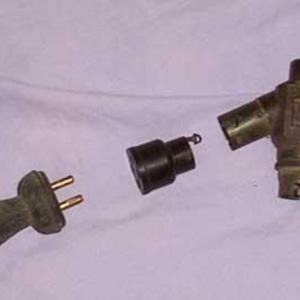You are using an out of date browser. It may not display this or other websites correctly.
You should upgrade or use an alternative browser.
You should upgrade or use an alternative browser.
5A sockets and shaver plugs
- Thread starter AndyPRK
- Start date
Sponsored Links
I've got one of those adapters somewhere.We had lots of handy adapters. Think granny used to plug the iron into the lighting bayonet.

Untitled
www.diynot.com
Need one for a GU10!
Used to be available all over the place. My first hit:I've got one of those adapters somewhere.
Need one for a GU10!
Yep remember them well back in the 60s that BC adaptor for ironing using a lighting circuit was quite common,We had lots of handy adapters. Think granny used to plug the iron into the lighting bayonet.
Folk never had enough sockets.
Not many had the UIK 13A plugs and sockets either.
Only "New Build" post war had any meaningful number of sockets anyway , one per dwelling or one per floor if you were lucky so the common two up two down terraced home might have two sockets, WOW! and if you had a cooker circuit fitted you could have an extra socket built in to the cooker control unit, used for kettle and any kitchen appliance like a washing machine etc.
Ho those were the days, ironing from a two wire lighting circuit and nobody bothered about earthing, earthing was for whimps .
In fact, even recent years, I`ve seen a few fluorescent light fittings wired in two core flex or even bell wire - "It does not need an earth, it works perfectly well without an earth!"
Even if you had electric for ceiling lighting you`d often have gas mantles for wall lighting and the lead pipes were often buried diagonally.
Sponsored Links
I vaguely suspect the two- and three-pin varieties may have been intentionally different to prevent people from using class 0 appliances (single-insulated, not earthed) in rooms with exposed earth potential. At least that was the reasoning behind designing German and French sockets to be incompatible with the old round-faced two-pin plugs. In theory, a room without any bonded metal pipes, structural elements or earthed electrics prevents fatal shocks even if someone was to touch a live part. In practice, rooms like that rarely existed.
If that was the reason I doubt it was very effective given that at that time most appliances in the UK didn't come from the manufacturer with plugs and plugs were expected to be fitted by the customer or maybe the retailer after asking what kind of plug the customer needed.I vaguely suspect the two- and three-pin varieties may have been intentionally different to prevent people from using class 0 appliances (single-insulated, not earthed) in rooms with exposed earth potential. At least that was the reasoning behind designing German and French sockets to be incompatible with the old round-faced two-pin plugs.
I do know that in addition to the BS plug types there were many manufactuer-specific plugs used in the UK.
Indeed , before the 13A fused plugs became King in the UK there was often a hotch potch assortment of plugs/sockets/connectors. It was a wonder that any of us actually survived/
I have come across a few example of old practices during my working life and think "Oh Heck, I remember some ot these being considered quite normal, Wow!"
I have come across a few example of old practices during my working life and think "Oh Heck, I remember some ot these being considered quite normal, Wow!"
By the time I was old enough to remember stuff most of the weirdness was gone. I remember my parents talking about our family home having weird plugs and sockets, which based on what I now know I think were "wylex plugs", but that was before I was old enough to remember anything. At least one of my sets of grandparents had round pin sockets.
I've also seen some disused wylex sockets around the University, no idea if they were still live.
I'm just about old enough to remember regular appliances being sold without plugs, before they became mandatory in the 1990s (though of course the law in question has loopholes big enough to drive a truck through).
I've also seen some disused wylex sockets around the University, no idea if they were still live.
I'm just about old enough to remember regular appliances being sold without plugs, before they became mandatory in the 1990s (though of course the law in question has loopholes big enough to drive a truck through).
If that was the reason I doubt it was very effective given that at that time most appliances in the UK didn't come from the manufacturer with plugs and plugs were expected to be fitted by the customer or maybe the retailer after asking what kind of plug the customer needed.
I do know that in addition to the BS plug types there were many manufactuer-specific plugs used in the UK.
It wasn‘t particularly effective elsewhere either. Earthed and non-earthed sockets side by side or non-earthed sockets right next to cast-iron radiators connected to bonded steel pipes used to be very common on the continent. Obviously requiring appliances to be sold with plugs did help a little. Germany had moulded rubber plugs as early as the 1920s, my great-gran‘s first vacuum cleaner had one.
DIYnot Local
Staff member
If you need to find a tradesperson to get your job done, please try our local search below, or if you are doing it yourself you can find suppliers local to you.
Select the supplier or trade you require, enter your location to begin your search.
Please select a service and enter a location to continue...
Are you a trade or supplier? You can create your listing free at DIYnot Local
Sponsored Links
Similar threads
- Replies
- 2
- Views
- 24K

